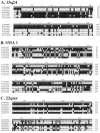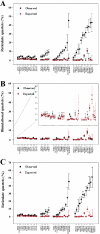Evidence for widespread reticulate evolution within human duplicons
- PMID: 16252241
- PMCID: PMC1271390
- DOI: 10.1086/497704
Evidence for widespread reticulate evolution within human duplicons
Abstract
Approximately 5% of the human genome consists of segmental duplications that can cause genomic mutations and may play a role in gene innovation. Reticulate evolutionary processes, such as unequal crossing-over and gene conversion, are known to occur within specific duplicon families, but the broader contribution of these processes to the evolution of human duplications remains poorly characterized. Here, we use phylogenetic profiling to analyze multiple alignments of 24 human duplicon families that span >8 Mb of DNA. Our results indicate that none of them are evolving independently, with all alignments showing sharp discontinuities in phylogenetic signal consistent with reticulation. To analyze these results in more detail, we have developed a quartet method that estimates the relative contribution of nucleotide substitution and reticulate processes to sequence evolution. Our data indicate that most of the duplications show a highly significant excess of sites consistent with reticulate evolution, compared with the number expected by nucleotide substitution alone, with 15 of 30 alignments showing a >20-fold excess over that expected. Using permutation tests, we also show that at least 5% of the total sequence shares 100% sequence identity because of reticulation, a figure that includes 74 independent tracts of perfect identity >2 kb in length. Furthermore, analysis of a subset of alignments indicates that the density of reticulation events is as high as 1 every 4 kb. These results indicate that phylogenetic relationships within recently duplicated human DNA can be rapidly disrupted by reticulate evolution. This finding has important implications for efforts to finish the human genome sequence, complicates comparative sequence analysis of duplicon families, and could profoundly influence the tempo of gene-family evolution.
Figures












Similar articles
-
Evolutionary analysis of the highly dynamic CHEK2 duplicon in anthropoids.BMC Evol Biol. 2008 Oct 2;8:269. doi: 10.1186/1471-2148-8-269. BMC Evol Biol. 2008. PMID: 18831734 Free PMC article.
-
Enrichment of segmental duplications in regions of breaks of synteny between the human and mouse genomes suggest their involvement in evolutionary rearrangements.Hum Mol Genet. 2003 Sep 1;12(17):2201-8. doi: 10.1093/hmg/ddg223. Epub 2003 Jul 8. Hum Mol Genet. 2003. PMID: 12915466
-
Comparative sequence analysis of the Gdf6 locus reveals a duplicon-mediated chromosomal rearrangement in rodents and rapidly diverging coding and regulatory sequences.Genomics. 2004 Nov;84(5):814-23. doi: 10.1016/j.ygeno.2004.07.009. Genomics. 2004. PMID: 15475260
-
Recent duplication, domain accretion and the dynamic mutation of the human genome.Trends Genet. 2001 Nov;17(11):661-9. doi: 10.1016/s0168-9525(01)02492-1. Trends Genet. 2001. PMID: 11672867 Review.
-
Lessons from the human genome: transitions between euchromatin and heterochromatin.Hum Mol Genet. 2001 Oct 1;10(20):2215-23. doi: 10.1093/hmg/10.20.2215. Hum Mol Genet. 2001. PMID: 11673404 Review.
Cited by
-
A preliminary comparative analysis of primate segmental duplications shows elevated substitution rates and a great-ape expansion of intrachromosomal duplications.Genome Res. 2006 May;16(5):576-83. doi: 10.1101/gr.4949406. Epub 2006 Apr 10. Genome Res. 2006. PMID: 16606706 Free PMC article.
-
A chromosomal rearrangement hotspot can be identified from population genetic variation and is coincident with a hotspot for allelic recombination.Am J Hum Genet. 2006 Nov;79(5):890-902. doi: 10.1086/508709. Epub 2006 Sep 26. Am J Hum Genet. 2006. PMID: 17033965 Free PMC article.
-
A recurrent inversion on the eutherian X chromosome.Proc Natl Acad Sci U S A. 2007 Nov 20;104(47):18571-6. doi: 10.1073/pnas.0706604104. Epub 2007 Nov 14. Proc Natl Acad Sci U S A. 2007. PMID: 18003915 Free PMC article.
-
An ancient repeat sequence in the ATP synthase beta-subunit gene of forcipulate sea stars.J Mol Evol. 2007 Nov;65(5):564-73. doi: 10.1007/s00239-007-9036-6. Epub 2007 Oct 2. J Mol Evol. 2007. PMID: 17909692
-
Recurrent duplication-driven transposition of DNA during hominoid evolution.Proc Natl Acad Sci U S A. 2006 Nov 21;103(47):17626-31. doi: 10.1073/pnas.0605426103. Epub 2006 Nov 13. Proc Natl Acad Sci U S A. 2006. PMID: 17101969 Free PMC article.
References
Web Resources
-
- Algorithms in Bioinformatics: SplitsTree4, http://www-ab.informatik.uni-tuebingen.de/software/splits/welcome.html (for D. H. Huson and D. Bryant's work on estimating phylogenetic trees and networks using SplitsTree4)
-
- NISC Comparative Vertebrate Sequencing, http://www.nisc.nih.gov/open_page.html?/projects/comp_seq.html (for Target 1)
-
- Pairwise FLAG, http://bioinformatics.itri.org.tw/prflag/prflag.php
References
-
- Altschul SF, Gish W, Miller W, Myers EW, Lipman DJ (1990) Basic local alignment search tool. J Mol Biol 215:403–410 - PubMed
-
- Bailey JA, Gu Z, Clark RA, Reinert K, Samonte RV, Schwartz S, Adams MD, Myers EW, Li PW, Eichler EE (2002) Recent segmental duplications in the human genome. Science 297:1003–1007 - PubMed
Publication types
MeSH terms
Grants and funding
LinkOut - more resources
Full Text Sources
Miscellaneous

